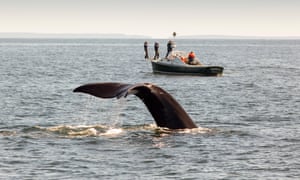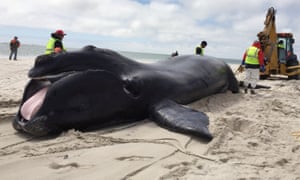Marine Animals At Risk of Extinction
"You do have to use the extinction word, because that's where the trend lines say they are. That's something we can't let happen."
John Bullard, National Oceanic and Atmospheric Administration
"The current status of the right whales is a critical situation, and using our available resources to cover right whales is of high importance and high urgency."
Mark Murray-Brown, Endangered Species Act consultant, NOAA
 |
|
There are only about 500 North Atlantic right whales in existence. (Center for Coastal Studies/NOAA)
|
Natural Resources Defense Council (NRDC), International Fund for Animal Welfare (IFAW), the League for Coastal Protection, Cetacean Society International, and Ocean Futures Society formed a coalition attempting to hold the U.S. Navy responsible for the damage its technology imposes on marine creatures. In a court brief, the coalition cited the Navy's own documents estimating that sonar testing was expected to kill 170,000 marine mammals, causing permanent injury to over 500 whales and deafness in 8,000 others.
 |
North Atlantic right whale breaks the ocean surface off Provincetown, Mass., in Cape Cod Bay.
Source: Associated Press |
Though two lower courts agreed with the coalition that the U.S. Navy is responsible for mayhem in the Pacific in particular, the U.S. Supreme Court ruled for the Navy, that it should be permitted to continue its mid-frequency sonar testing as a requirement upholding national security. "The U.S. Navy could use a number of proven methods to avoid harming whales when testing mid-frequency sonar", objected IFAW’s Fred O'Regan. "Protecting whales and preserving national security are not mutually exclusive."
This has been a dreadful year for one of the most endangered whales on Earth, the North Atlantic right whale. In 2017 alone, seventeen of the gigantic oceanic mammals have died, and scientists are puzzled by the cause, although speculation is rife. According to the National Oceanic and Atmospheric Administration only about 450 right whales are left alive; when 17 of their number expire the situation verges toward the existentially catastrophic.
John Bullard of NOAA, views the threatened existence of right whales of such momentous crisis he feels that regulators in the United States and Canada are required to step in, because if nothing is soon done to help their recovery, they simply will not manage on their own to recover, and the planet will lose another important species whose presence at the moment in such scarce numbers is already rare.
 |
| A North Atlantic right whale dives, near a New England Aquarium research boat. Photograph: Alamy |
Marine mammal researchers are doubly concerned that the year 2017 has been a poor reproduction year, and added to that the high rate of mortality, the prognosis presents as beyond grim. Scientists estimate that roughly 100 breeding female North Atlantic right whales are now left to contribute what they can to the swiftly diminishing pool. Females have been dying at greater rates than males in a species decline that has accelerated since 2010.
The proliferating presence of ever-larger sea-going vessels is certainly one of the reasons these giant marine species are facing extinction. It's a hugely uneven contest when an immense steel-hulled vessel challenges the right-of-way of a living creature. The sounds emitted by ocean-going vessels confuse and disorient whales. Military vessels' use of sonar equipment generate sound waves that assail the whales with high-decibel sound for hundreds of miles causing whales to attempt to escape the sounds with often deleterious results when whales become beached.
 |
| At least 14 right whales have been found dead in Canadian and U.S. waters this year. At least 11 of those were found in Canadian waters and it's not clear whether some of the carcasses that washed up in Newfoundland had drifted from where they were first spotted in the Gulf of St. Lawrence. (CBC) |
Fishing vessels setting out their fishing gear are frequently cited causes of the death of whales as a result of gear entanglement. Giving birth in temperate southern waters, the animals then travel to New England and Canada in spring and summer, their traditional feeding grounds. Every one of the 17 deaths occurred off the coasts of New England and the Canadian Maritimes.
Recent scientific studies offer other hypotheses. One, published in the journal Nature Scientific Reports points to whales moving about far more than has been previously assumed, with some scientists suggesting that whales could be venturing far from traditional protected areas searching for food, and in this manner placing themselves in harm's way.
Yet another study published in the journal Endangered Species Research recounted that scientists found whales that suffer long entanglements in fishing gear produce hormone levels indicating high stress, revealed by studying their feces. That stress impacts negatively on reproductive capacity, should they survive the entanglement event.
The development of a long-term plan to monitor the right whale population trends and habitat, and to study the impact of commercial fishing on right whales has been recommended in protection of the species, an initiative of a five-year NOAA review.
 |
| A rare North Atlantic right whale calf lies dead on a beach in Chatham, Massachusetts in 2016. Photograph: AP |
Labels: Canada, Endangered Species, Regulation, United States, Whales

0 Comments:
Post a Comment
<< Home